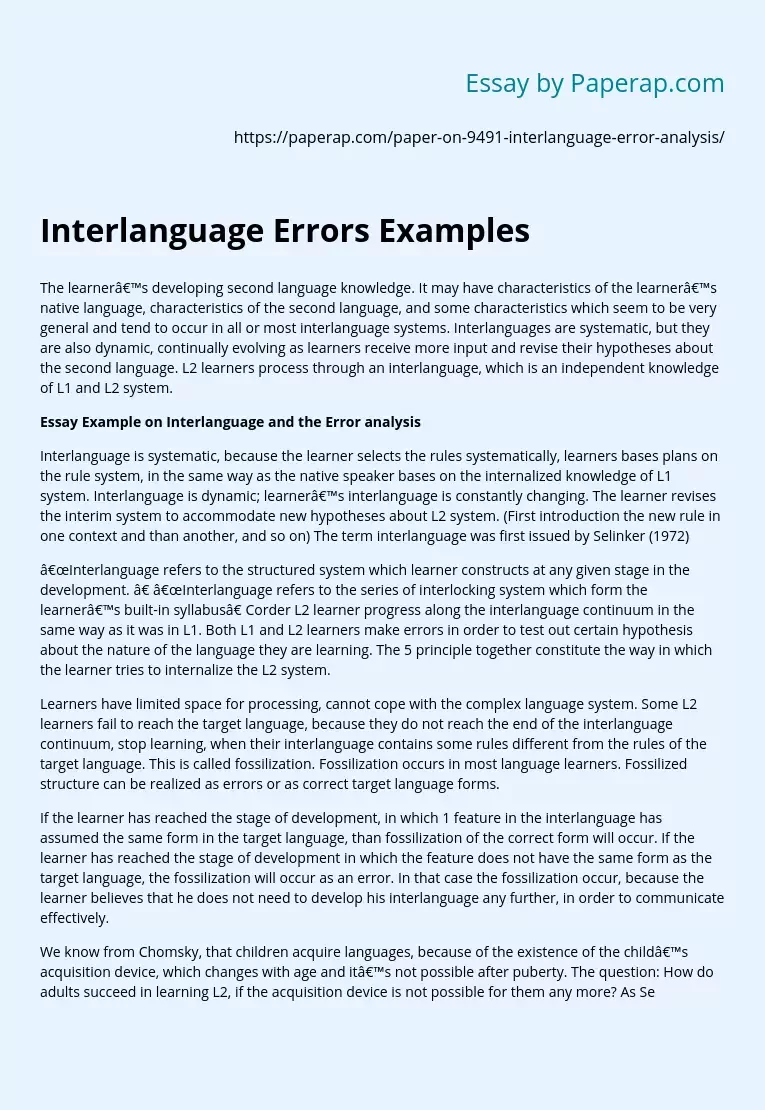Interlanguage Errors Examples
The learner’s developing second language knowledge. It may have characteristics of the learner’s native language, characteristics of the second language, and some characteristics which seem to be very general and tend to occur in all or most interlanguage systems. Interlanguages are systematic, but they are also dynamic, continually evolving as learners receive more input and revise their hypotheses about the second language. L2 learners process through an interlanguage, which is an independent knowledge of L1 and L2 system.
Essay Example on Interlanguage and the Error analysis
Interlanguage is systematic, because the learner selects the rules systematically, learners bases plans on the rule system, in the same way as the native speaker bases on the internalized knowledge of L1 system.
Interlanguage is dynamic; learner’s interlanguage is constantly changing. The learner revises the interim system to accommodate new hypotheses about L2 system. (First introduction the new rule in one context and than another, and so on) The term interlanguage was first issued by Selinker (1972)
“Interlanguage refers to the structured system which learner constructs at any given stage in the development.
” “Interlanguage refers to the series of interlocking system which form the learner’s built-in syllabus” Corder L2 learner progress along the interlanguage continuum in the same way as it was in L1. Both L1 and L2 learners make errors in order to test out certain hypothesis about the nature of the language they are learning. The 5 principle together constitute the way in which the learner tries to internalize the L2 system.
Learners have limited space for processing, cannot cope with the complex language system. Some L2 learners fail to reach the target language, because they do not reach the end of the interlanguage continuum, stop learning, when their interlanguage contains some rules different from the rules of the target language. This is called fossilization. Fossilization occurs in most language learners. Fossilized structure can be realized as errors or as correct target language forms.
If the learner has reached the stage of development, in which 1 feature in the interlanguage has assumed the same form in the target language, than fossilization of the correct form will occur. If the learner has reached the stage of development in which the feature does not have the same form as the target language, the fossilization will occur as an error. In that case the fossilization occur, because the learner believes that he does not need to develop his interlanguage any further, in order to communicate effectively.
We know from Chomsky, that children acquire languages, because of the existence of the child’s acquisition device, which changes with age and it’s not possible after puberty. The question: How do adults succeed in learning L2, if the acquisition device is not possible for them any more? As Selinker argued that those adults, who successfully achieve native-speaker proficiency in the TL, do so, because they continue to make use of acquisition device and they are able to transform the universal grammar into the structure of the grammar of the target language.
But those adults who cannot achieve proficiency is because, they are unable to reactivate the acquisition device. Until 1960, the prevention of errors was more important, than the identification of errors. It was Corder, who first realised the importance of analysing the learner’s errors (1967). As I said before, both L1&L2 learners make errors in order to test out certain hypothesis about the nature of the language, they are learning.
Corder saw the making of errors as a strategy, evidence of learners internal processing. This was in opposition of the view of behaviourist psychology, presented in the Contrastive Analysis before. Because Contrastive analysis believed that errors produced by the L2 learner, result from the interference of L1,Contrastive analysis was based on the comparison of L1 and L2, and teacher were aware of the errors. The new interest in errors was the recognition that they provide information about the process of acquisition.
Interlanguage Errors Examples. (2019, Nov 27). Retrieved from https://paperap.com/paper-on-9491-interlanguage-error-analysis/

